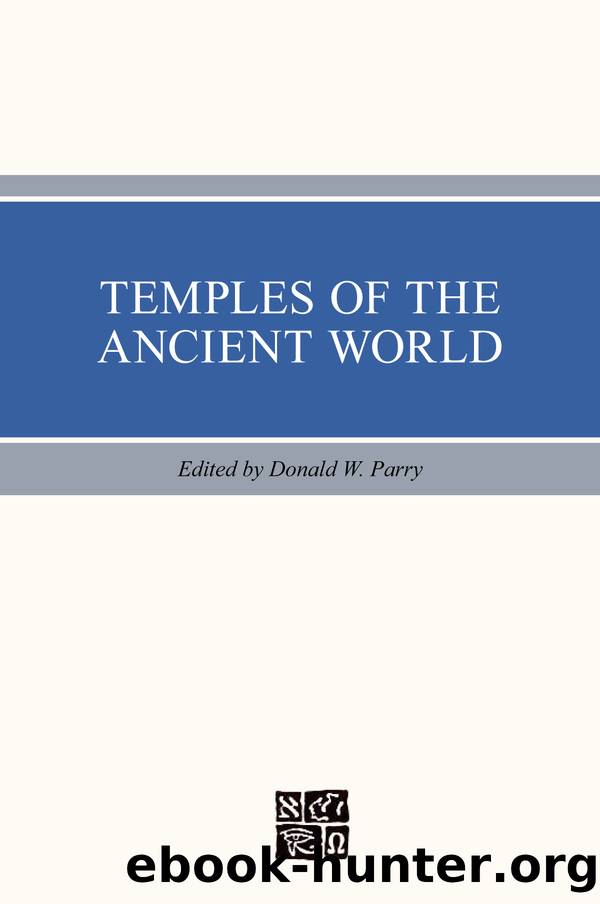Temples of the Ancient World by Donald W. Parry

Author:Donald W. Parry [Donald W. Parry]
Language: eng
Format: epub
ISBN: 9781629733364
Publisher: Deseret Book Company
Published: 2017-05-16T00:00:00+00:00
Conclusion
The temple in the Book of Mormon is a complex subject. Some facts about Nephite temples are obvious and clear; others are subtle, obscure, and inferential. Drawing general conclusions is difficult and challenging. Nevertheless, although most readers probably assume that the Book of Mormon contains very little information about temples, dozens of precious pieces of information can be coaxed out of the text with little or no coercion.
The Nephite record bridges both Jewish and Christian backgrounds. The world of the Book of Mormon is neither Jewish nor Christian, but both, if properly understood. Nephite temples were infused with both the strict observance of the law of Moses and the prophetic comprehension of the gospel of Jesus Christ. The Book of Mormonâs invitation to harmonize the word of God in all of its dispensations and manifestations and its ability to unify both testaments of the Bible are perhaps two of its most important, and yet most often overlooked, strengths in todayâs world of oftenstrained Jewish and Christian relationships. No other text better shows a religious group valuing both the strict observance of the law of Moses and its fulfillment in Jesus Christ.
From the time of Lehi, to the temple period of Nephi and Jacob, to the temple convocations in Zarahemla and Bountiful, changes occurred among the Nephites with respect to the templeânot changes in the eternal aspects of the gospel, but changes in practice, priestly and ecclesiastical organization, and emphasis. In the earlier periods, the temple played a greater political role, especially in conjunction with the establishment and enhancement of kingships. Later, King Benjaminâs speech was filled with specific Israelite themes and terms, particularly those characteristic of the holy celebrations of the Day of Atonement and Feast of Tabernacles, which he infused with Christian knowledge and perspectives. By the time of Alma the Younger, following the abandonment of kingship in the land of Zarahemla, the political function of the temple diminished, and the Israelite elements become far less obvious. Almaâs emphasis was on teaching the plan of salvation, cultivating personal righteousness, and regularizing local church worship. With the coming of Christ in 3 Nephi, blood sacrifice and burnt offerings came to an end, and a new sacred order was established. The differences between that new order and the prior Nephite ritual order were great enough that the people saw the continuity between the two and yet were amazed and astonished at how all of the old had become new, evidently down to minute details.
In light of all that can be said about temples in the Book of Mormon, it is finally well to remember that in 1829, when the Book of Mormon was translated, Joseph Smith had scarcely thought or dreamed of a temple. Two years later he and the Church would move to Kirtland, where a temple was dedicated in 1836. The ordinances of washing, anointing, and the washing of feet were performed in that temple, but the full endowment was not given until 1843 in Nauvoo. Joseph Smith did
Download
This site does not store any files on its server. We only index and link to content provided by other sites. Please contact the content providers to delete copyright contents if any and email us, we'll remove relevant links or contents immediately.
FOX'S BOOK OF MARTYRS by Adrian Ebens(231)
(eng) Mervyn Peake - Gormenghast 2.5 by Boy in Darkness(182)
The Second Coming of Saturn: The Great Conjunction, Americaâs Temple, and the Return of the Watchers by Derek P. Gilbert(181)
The origins of violence by John Docker(158)
Llewellyn's 2024 Sabbats Almanac by Llewellyn Publishing(149)
English Cathedral & Monastic Carpentry by Cecil A. Hewett(142)
The Lesser Key of Solomon by Samuel Liddell MacGregor Mathers(134)
668113337 by Unknown(134)
Journey through the Text of "A Course in Miracles by Kenneth Wapnick Ph.D(134)
The Second Coming of Gluttony: 1-489 by FudgeNouget(132)
The Knights Templar and their myth by Peter Partner Murdered magicians(127)
The Healing Power of Kindness âVolume 1: Releasing Judgment by Kenneth Wapnick(127)
THE ORIGIN OF ALL RELIGIOUS WORSHIP by DUPUIS(126)
Tao of Wing Chun Do by (Volume 2 Chi Sao)(126)
Being, While Knowing That You Are Not: Surrendering to the sadness and madness of life (Reality Explained Trilogy Book 2) by Marc Leavitt(117)
Llewellyn's 2023 Sabbats Almanac by Elizabeth Barrette(114)
Lillian Too's Irresistible Feng Shui Magic by Lillian Too(113)
Pain Is Inevitable, Misery Is Optional by Hyrum W. Smith & Gerreld L. Pulsipher(110)
978-3-031-46661-8 by Unknown(110)
